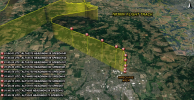My only comment is that pilot schools become pilot factories and it takes calendar time to develop reflexes, judgment, deep knowledge, understanding and muscle memory. . . and a first flight isn't a great time to do VMC instruction because of overloaded brain functioning in a new environment. But here is the NTSB report:
- NTSB issues the preliminary report into the fatal accident involving a Piper PA-44-180 Seminole, N8360K, that occurred on October 3, 2023, in Newberg, Oregon:
On October 3, 2023, about 1847 Pacific daylight time, a Piper PA-44-180, N8360K, was substantially damaged when it was involved in an accident near Newberg, Oregon. The flight instructor and the pilot receiving instruction were fatally injured; a pilot rated passenger was seriously injured. The airplane was operated as a Title 14 Code of Federal Regulations Part 91 instructional flight.
A representative from the operator reported that, the pilot receiving instruction had recently obtained a commercial pilot certificate with an airplane single engine land rating and the accident flight was his first flight in his multi engine training program. They added that it is common for the first multi engine training flight to include slow flight, power off stalls, power on stalls, accelerated stalls, Minimum control airspeed (VMC) demonstration, emergency maneuvers, and steep turns.
Recorded Automatic Dependent Surveillance-Broadcast (ADS-B) data provided by the Federal Aviation Administration (FAA) showed that the airplane departed Portland-Hillsboro Airport (HIO) at 0118:21 and ascended to 1,200 ft mean sea level (msl) before a left turn was initiated. The airplane continued on a western heading and ascended to an altitude of about 3,400 ft msl. At 0125:35 the airplane made a left turn to the south and ascended to an altitude of 5,300 ft msl. At 0130:46 the airplane made a left 180° turn to the north, then made a right turn to the northeast. The data showed the airplane continued on a northeast heading for about 3 minutes, before a series of 360° turns to the left and right were performed. At the completion of the turns, the airplane turned to the southwest. The data showed that at 0143:48, the airplane made a left turn to the southeast. While on a southeasterly heading, the airplane’s ground speed began to decrease from 133 kts. At 0145:56 the data showed the airplanes ground speed had decreased to 69 kts, at an altitude of 5750 ft msl, and began to descend on a southeasterly heading. The last recorded ADS-B target, at 0146:38, was located about 50 ft northwest of the accident site at an altitude of 525 ft, as seen in figure 1.
Multiple witnesses located near the accident site reported observing the airplane in level flight before it pitched downward and entered a near-vertical descent. The airplane continued in a nose-low, near-vertical descent until the airplane went out of visual range. Several witnesses described the airplane as “spinning” or “spiraling” during various phases of the vertical descent.
Examination of the accident site revealed that the airplane impacted a single-story residential structure, substantially damaging the fuselage and wings. The airplane came to rest in a near vertical attitude in the residential structure, on a heading of about 285° magnetic at an elevation of 249 ft msl. No visible ground scars were observed surrounding the wreckage. All major structural components of the airplane were located within about 10 ft of the main wreckage. The wreckage was recovered to a secure location for further examination.

Latitude, Longitude: 45.31399,-122.94885
- Report:
https://data.ntsb.gov/.../GenerateNewestReport/193187/pdf
